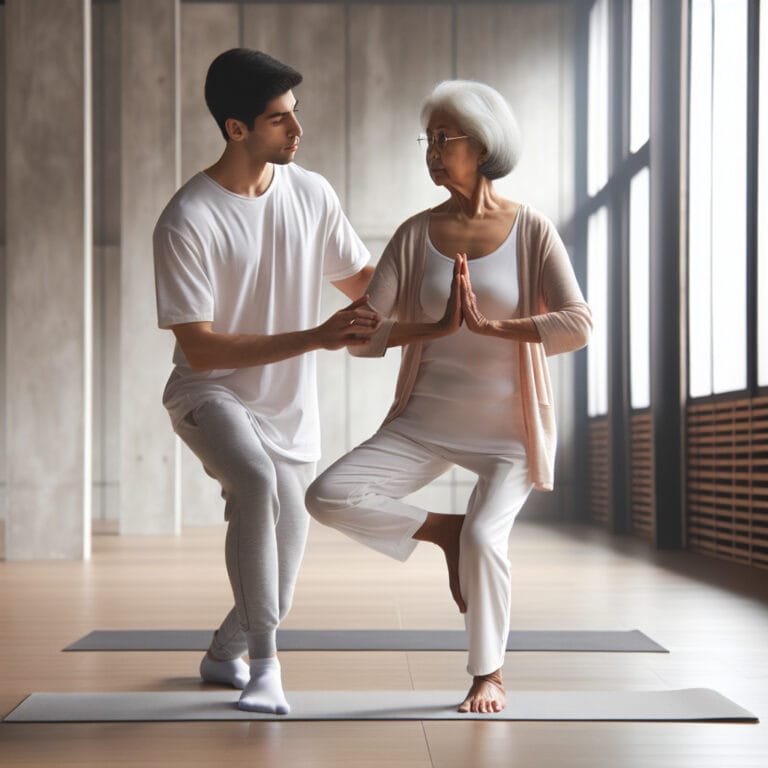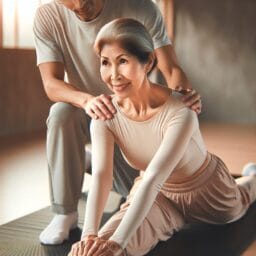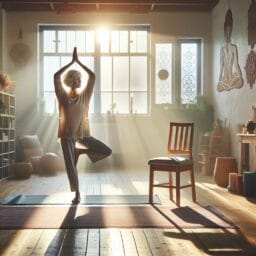
Unlocking Stability: Yoga for Improving Balance in Seniors
Table of Contents
- Introduction
- Understanding Balance
- Yoga and Balance
- Best Yoga Poses for Balance
- Safety Tips for Seniors Practicing Yoga
- Conclusion
- Frequently Asked Questions
Introduction
The importance of maintaining good balance cannot be overstated, especially in the golden years of life. As we age, our ability to maintain equilibrium can diminish, leading to a higher risk of falls and subsequent injuries. Seniors often face issues with balance due to various factors such as changes in body composition, strength decline, or even certain medical conditions. This is where Yoga comes into play as an effective solution. Practicing yoga regularly has been shown in several studies to significantly improve balance control among seniors.
The beauty of yoga lies not just in its physical benefits but also in its holistic approach towards wellness. It incorporates elements of strength training exercises and static-dynamic poses that enhance overall body stability while subtly working on one’s flexibility and endurance levels. For instance, the Mountain Pose (a basic standing pose) requires your feet hip-width apart while your hands remain parallel to each other- it is a quintessential example of how practicing yoga encourages senior citizens to focus on their postural alignment and core strength.
Moreover, systematic reviews show promising results for yoga as an effective tool for balance training among older adults – arguably even more beneficial than traditional physical education methods like sport palestra wellness regimes. One study showed that female seniors who practiced Yin Yoga had significant improvements in their total balance scores assessed by the Tinetti Balance Assessment Tool when compared with a control group.
However, practicing yoga safely is paramount – this includes following correct techniques for each pose and taking necessary precautions based on individual health conditions or limitations. Healthcare professionals recommend starting slowly under expert supervision or through guided online classes specifically tailored for older adults before exploring harder poses independently.
It’s encouraging to see that many communities are acknowledging these benefits and incorporating yoga sessions into their healthcare routines for seniors – both at home & local community centers alike; making them conveniently accessible via area-specific on-demand videos work well too!
To recap: Seniors can enhance their agility by integrating Yoga into their daily routine while ensuring safety precautions are in place. So why not give it a try? After all, balance isn’t something we find, it’s something we create.
Understanding Balance
A fascinating fact about aging is that it may negatively affect one’s balance due to changes in body composition, loss of muscular strength, and sometimes specific health conditions. The simple act of standing still on a bus or putting on shoes can become daunting tasks for many seniors – tasks that most younger individuals carry out without a second thought. Balance isn’t just about preventing falls and subsequent injuries but is essential for accomplishing day-to-day activities with ease.
Diving into the realm of scientific research highlights this issue amongst older adults further. One systematic review specifically compared balance control in healthy populations with older adults, revealing a stark difference between the two groups’ outcome measures. The study utilized sensitive measures such as static balance tests, which confirmed reduced stability amongst seniors.
But there’s hope! It comes not from expensive healthcare interventions or complicated medical alert systems but rather from an ancient practice: Yoga. According to a separate controlled study involving female seniors, practicing yoga regularly significantly improved total balance scores assessed by the Tinetti Balance Assessment Tool compared to those who didn’t partake in any form of exercise (the control group). Intriguingly enough, these benefits weren’t limited only to static balance but extended to dynamic equilibrium too – crucial for actions like walking or climbing stairs.
At first glance, yoga poses might seem like they’re all about flexibility; however, even basic ones like Mountain Pose involve maintaining feet hip-width apart while keeping hands parallel—all aimed at enhancing stability by finely tuning postural alignment and core strength. Other poses require hips roll gently over feet while focusing on steady breaths repeat patterns—transforming yoga into not just an exercise routine but also a meditative experience that helps keep the mind focused—a vital aspect often overlooked when discussing physical activities.
Yoga offers diverse benefits across different pose types from strengthening lower back muscles through certain floor flex movements to improving leg butt strength via various standing exercises. Each pose strengthens specific parts of our bodies contributing towards better balance control, whether it is executing harder lifts or maintaining body posture.
Safety tips for seniors are paramount when practicing yoga. It’s crucial to start slow, ideally under the guidance of a healthcare professional or through specially-designed online or in-person classes tailored for older adults. That way, each pose can be executed correctly while taking necessary precautions based on individual health conditions and physical limitations.
So consider yoga as an ideal complement to traditional physical education methodologies like sport palestra wellness regimes that are often difficult for seniors to maintain. Encouragement from peers and caregivers can go a long way in helping older adults stick with this routine and gradually improve their balance – all while enjoying the journey towards healthier aging!
| Title | Content |
|---|---|
| Understanding Balance | Balance may be negatively affected during aging due to changes in body composition, loss of muscular strength, and sometimes specific health conditions. |
| Scientific Research | Studies show a stark difference in balance control between healthy populations and older adults. Static balance tests indicate reduced stability amongst the elderly. |
| Yoga as a Solution | Regular yoga practice can significantly improve balance scores in older adults, extending benefits to both static and dynamic equilibrium. |
| Benefits of Yoga | Yoga poses enhance stability, postural alignment, and core strength. Each pose strengthens specific parts of the body contributing towards better balance control. |
| Safety Tips | Seniors should start slow with yoga, ideally under professional guidance or through classes tailored for older adults. This ensures correct execution of poses and necessary precautions based on individual health conditions and physical limitations. |
| Encouragement and Support | Encouragement from peers and caregivers can help older adults stick with yoga and gradually improve their balance, promoting healthier aging. |
Yoga and Balance
While the physical education methodologies of sport palestra wellness are often challenging for seniors to maintain, yoga provides a gateway to enhance balance and stability without strenuous exertion. The intricacy of yoga goes beyond mere flexibility as it subtly and effectively strengthens core muscles that contribute significantly towards maintaining equilibrium in daily life. For instance, the Mountain Pose is more than just standing still, it’s a powerful pose that makes seemingly passive body parts active by keeping feet hip-width apart while ensuring hands stay parallel – an exercise in postural alignment.
Recent scientific research has validated the importance of incorporating these practices into aging routines. In one systematic review comparing balance control between a healthy population and older adults, it was found that practicing yoga consistently led to improved total balance scores among senior citizens. Moreover, Yin Yoga, particularly popular among female seniors due its gentleness yet effectiveness, demonstrated significant improvements in both static and dynamic equilibrium.
In terms of safety precautions during this journey towards improved balance through yoga, certain steps can be followed for maximum benefit with minimal risk. Firstly, start slow under guidance from experienced teachers or healthcare professionals; also consider online or in-person classes specifically designed for older adults’ needs and limitations. Secondly, become familiar with each pose’s anatomy from a-z using resources like pose library blogs or specific guides on yoga health benefits – this will not only help avoid injuries but also maximize the benefit derived from each posture.
A valuable tip could involve establishing a focal point during poses – this helps maintain concentration and reduces chances of falling over while attempting harder lifts. Also remember that alternating sides while practicing poses ensures balanced strength development across your body – if you stretch right leg forward during Warrior I pose today, begin opposite side on next session making movements symmetrical over time.
While courage is needed initially to overcome apprehensions around new activities like yoga at an advanced age stage; backing from family members and caregivers plays crucial role in keeping motivation levels high providing necessary encouragement for continuation. It’s not just about physical health as yoga also aids mental tranquility which indirectly improves balance control due to mind-body connection. To recap, yoga offers a holistic solution for seniors to improve balance that fosters both body strength and mental peace while ensuring safety measures are adhered to throughout the journey.
Best Yoga Poses for Balance
While the concept of yoga might be daunting for seniors, there is an array of poses that can be incorporated into their routine to enhance balance and stability. For instance, the Mountain Pose serves as a foundation for all other standing poses in yoga. It’s not just about keeping your feet hip-width apart with parallel hands; it’s about aligning your body composition from head to toe while engaging core muscles – a perfect blend of strength training exercise and meditative focus. This pose subtly improves static balance, contributing significantly towards better control over day-to-day activities.
Another gentle yet effective type of yoga beneficial to seniors is Yin Yoga. This practice involves holding floor-based poses for longer periods allowing deep tissues like fascia, ligaments and joints time to stretch and release – enhancing both static and dynamic balance over time. A systematic review concurs, revealing improved total balance scores among senior citizens who practiced Yin Yoga regularly.
Seniors can also engage in regular practice of the Warrior I pose. While executing this pose may involve some effort at first, remember the benefits outweigh any initial discomforts. The posture promotes lower back strength through floor flex movements while focusing on breath control with steady breaths repeat patterns- all contributing towards enhanced postural alignment.
Safety during these practices cannot be overstated especially when considering older adults’ bodily limitations due to aging or specific health conditions. Hence, before diving straight into self-practice, consider seeking advice from a healthcare professional or join tailored online classes specifically designed for seniors promoting safe practice environment featuring area-specific on-demand videos work well too! Also remember these two valuable tips: establishing a focal point during each pose helps reorient attention if you feel unstable; secondly alternating sides while practicing ensures balanced strength development across your body – if you led with left leg in Warrior I today make sure opposite side make similar movement next session thereby maintaining symmetry over time.
Incorporating regular yoga practice into daily routine will not only improve balance amongst seniors but also contribute towards a healthier lifestyle. While the initial steps may seem challenging, perseverance coupled with necessary encouragement from family and caregivers can lead to significant improvements in both physical health and mental tranquility over time. With yoga poses like Mountain Pose or Yin Yoga, achieving full potential becomes easier, making regular activities less daunting – all while ensuring safety precautions are duly followed. Through consistent practice, senior citizens can begin to experience not just improved balance but enhanced overall wellbeing – a much-needed recap for healthy aging!
Safety Tips for Seniors Practicing Yoga
In the journey towards improved balance, it is key to acknowledge that practicing yoga does not just involve executing poses. It calls for an understanding of the anatomy of these poses in order to avoid injuries and maximize benefits. For seniors venturing into yoga, this notion holds even more weight due to certain limitations aging may bring about. An important part of this journey involves taking necessary precautions while practicing yoga, a fundamental aspect often highlighted in a seniors safety blog or caregiver guides on fall prevention.
To begin with, consulting a healthcare professional before starting any new physical regimen should be a non-negotiable step. They can provide individualized advice based on existing health conditions and potential risks involved. This personal evaluation could be instrumental in avoiding subsequent injuries during practice.
Another significant precaution is being aware of one’s body composition and respecting its unique capabilities while attempting various poses. A crucial yet often overlooked tip is maintaining feet hip-width apart during standing poses like the Mountain Pose, which provides enhanced stability. Ensuring hands are parallel or letting hips roll gently over your feet can subtly improve alignment and facilitate better control over movements.
During practice, establishing a focal point can help maintain concentration and improve balance control – especially beneficial when attempting harder lifts or maintaining static-dynamic poses for longer periods such as Yin Yoga which boosts both static balance and dynamic equilibrium among older adults.
Additionally, alternating sides during each pose helps ensure balanced strength development across the body – if you’d led with your left leg today in Warrior I pose for instance; make sure the opposite side matches similar movement next time around thereby fostering symmetry over time.
Lastly but importantly is ensuring senior citizens feel encouraged throughout their yoga journey – either by caregivers at home or via local community sessions providing online in-person classes tailored specifically for them featuring area-specific on-demand videos work well too! With consistent practice under safe circumstances, yoga has been proven to significantly contribute towards improving balance among seniors leading to healthier aging!
Conclusion
As the golden years progress, balance control can be a daunting challenge for seniors. But there’s hope; Yoga, an ancient practice holds the potential to drastically improve balance among older adults. According to systematic reviews, consistent yoga practice has shown significant enhancements in total balance scores among senior citizens. The secret lies not just in executing yoga poses but understanding their anatomy from A-Z – every pose strengthens specific parts of the body drawing parallels with strength training exercises, contributing towards better body composition and enhanced overall stability. Sure enough, safety precautions are paramount: starting slow under professional guidance or through special classes designed for seniors is key; also remember while practicing poses like Mountain Pose or Yin Yoga with feet hip-width apart and parallel hands helps enhance static dynamic equilibrium. An inspiring focal point during each session ensures concentration is maintained; alternating sides further promotes symmetric strength development across the body—fostering balanced aging! Beyond physical benefits, practicing Yoga also aids mental tranquility indirectly improving balance control due to mind-body connection—it’s indeed a full potential package for healthier aging! The journey might seem challenging at first but with encouragement from caregivers and healthcare professionals coupled with perseverance, seniors can reap immense benefits of this holistic approach towards maintaining agility—an ideal recap on why it’s time you considered integrating Yoga into your routine!



